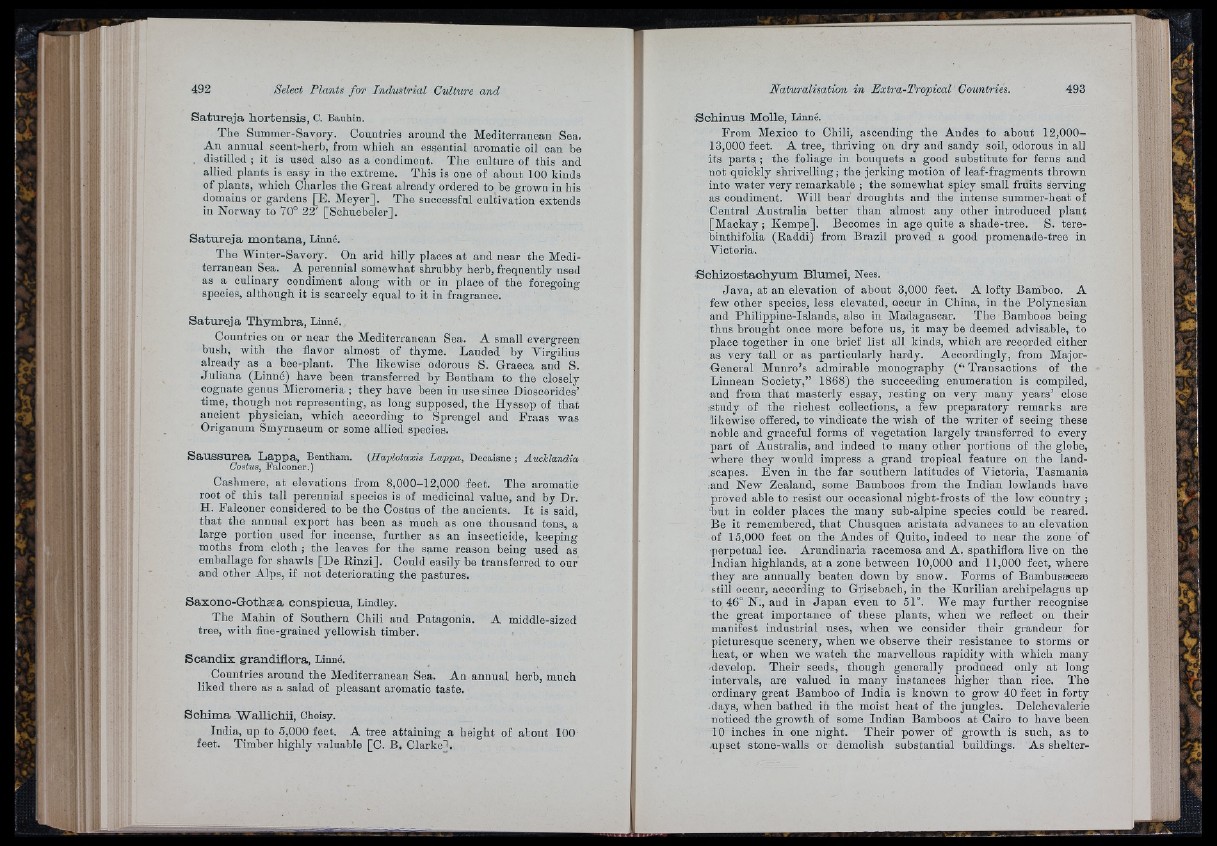
Satureja hortensis, C. Bauhin.
The Summer-Savory. Countries around the Mediterranean Sea.
An annual soeut-herb, from which an essential aromatic oil can be
, distilled ; it is used also as a condiment. The culture of this and
allied plants is easy in the extreme. This is one of about 100 kinds
of plants, which Charles the Great already ordered to be grown iu his
domains or gardens [E. Meyer]. The successfnl cultivation extends
iu Norway to 70° 22' [Schuebeler].
Satureja montana, Linné.
The Winter-Savory. On arid hilly places a t and near the Mediterranean
Sea. A perennial somewhat shrubby herb, frequently used
as a culinary condiment along with or in place of the foregoing
species, although it is scarcely equal to it in fragrance.
Satureja Thymbra, Linné.
Countries on or near the Mediterranean Sea. A small evergreen
bush, with the flavor almost of thyme. Lauded by Virgilius
already as a bee-plant. The likewise odorous S. Graeca and S.
Juliana (Linné) have been transferred by Bentham to the closely
cognate genus Micromeria ; they have been in use since Dioscorides’
time, though not representing, as long supposed, the Hyssop of that
ancient physician, which according to Sprengel and Fraas was
Origanum Smyruaeum or some allied species.
Saussurea Lappa, Bentham.
Gostms, Falconer.)
(Haplotaxis Lappa, Decaisne ; Auchlandia
Cashmere, a t elevations from 8,000-12,000 feet. The aromatic
root of this tall perennial species is of medioinal value, and by Dr.
H. Falconer considered to he the Costus of the ancients. I t is said,
th a t the annual export has been as much as one thousand tons, a
large portion used for incense, further as an insecticide, keeping
moths from cloth ; the leaves for the same reason being used as
emballage for shawls [De Rinzi]. Could easily he transferred to onr
and other Alps, if not deteriorating the pastures.
Saxono-Gothsea conspicua, Lindley.
The Mahin of Southern Chili and Patagonia,
tree, with fine-grained yellowish timber.
A middle-sized
Scandix grandiflora, Linné.
Countries around the Mediterranean Sea. An annual herb, much
liked there as a salad of pleasant aromatic taste.
Schima 'Wallichii, Choisy.
India, up to 5,000 feet. A tree attaining a height of ahout 100
feet. Timber highly valuable [C. B. Clarke].
Schinus Molle, Linné.
From Mexico to Chili, ascending the Andes to about 12,000-
13,000 feet. A tree, thriving on dry and sandy soil, odorous iu all
its parts, ; the foliage in bouquets a good substitute for ferns and
not quickly shrivelling ; the jerking motion of leaf-fragments thrown
into water very remarkable ; the somewhat spicy small fruits serving
as condiment. Will bear droughts and the intense summer-heat of
Central Australia better than almost any other introduced plant
[Mackay ; Kempe]. Becomes in age quite a shade-tree. S. tere-
binthifolia (Raddi) from Brazil proved a good promenade-tree in
Victoria.
■Schizostachyum Blumei, Nees.
Ja v a , at an elevation of about 3,000 feet. A lofty Bamboo. A
few other species, less elevated, occur in China, in the Polynesian
and Philippine-Islands, also in Madagascar. The Bamboos being
thus brought once more before us, it may be deemed advisable, to
place together iu one brief list all kinds, which are recorded either
as very tall or as particularly hardy. Accordingly, from Major-
General Munro’s admirable mouography (“ Transactions of the
Linnean Society,” 1868) the succeeding enumeration is compiled,
and from th a t masterly essay, resting on very many years’ close
study of the richest collections, a few preparatory remarks are
likewise ofEered, to vindicate the wish of the writer of seeing these
noble and graceful forms of vegetation largely transferred to every
part of Australia, and indeed to many other portions of the globe,
where they would impress a grand tropical feature on the landscapes.
Even in the far southern latitudes of Victoria, Tasmania
and New Zealand, some Bamboos from the Indian lowlands have
proved able to resist our occasional night-frosts of the low country ;
h u t in colder places the many suh-alpine species could be reared.
Be it remembered, th a t Chusquea aristata advances to an elevation
of 15,000 feet ou the Andes of Quito, indeed to near the zone of
■perpetual ice. Arundinaria racemosa aud A. spathiflora live on the
Indian highlands, at a zone between 10,000 and 11,000 feet, where
tlrey are annually beaten down by snow. Forms of Bambusaiceæ
still occur, according to Grisebach, in the Kurilian archipelagus up
to 46° N., aud in Jap an even to 51°. We may further recognise
the great importance of these plants, when we reflect on their
manifest industrial uses, when we consider their grandeur for
ficturesque scenery, when we observe their resistance to storms or
leat, or when we watch the marvellous rapidity with which many
develop. Their seeds, though generally produced only a t long
intervals, are valued in many instances higher than rice. The
ordinary great Bamboo of India is known to grow 40 feet in forty
days, when bathed iu the moist heat of the jungles. Delchevalerie
noticed the growth of some Indian Bamboos at Cairo to have been
10 inches in one night. Their power of growth is such, as to
.upset stone-walls or demolish substantial buildings. As shelter